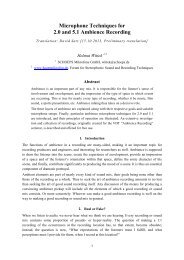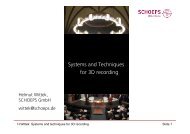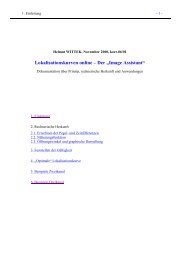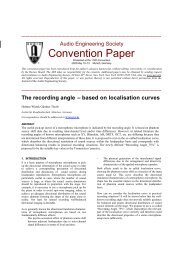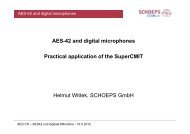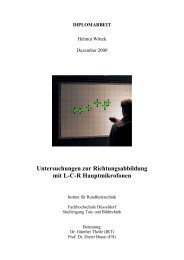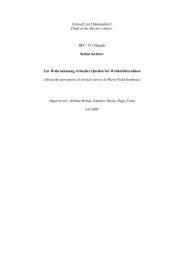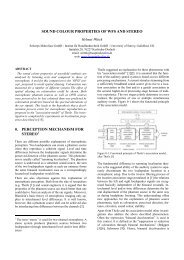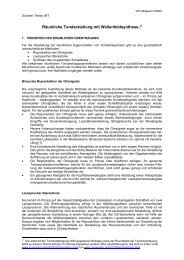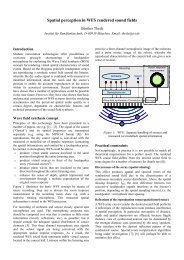on the localisation in the superimposed soundfield - Hauptmikrofon ...
on the localisation in the superimposed soundfield - Hauptmikrofon ...
on the localisation in the superimposed soundfield - Hauptmikrofon ...
Create successful ePaper yourself
Turn your PDF publications into a flip-book with our unique Google optimized e-Paper software.
18<br />
clearly detectable<br />
just about detectable<br />
Figure 8:<br />
Overview of results, see text<br />
2. The attributes’ dependency <strong>on</strong>to <strong>the</strong> test signals is apparent from <strong>the</strong> overview<br />
of <strong>the</strong> results given <strong>in</strong> Figure 8. The test signals have been sorted al<strong>on</strong>g <strong>the</strong><br />
abscissa <strong>in</strong> such a way that an <strong>in</strong>/decreas<strong>in</strong>g trend <strong>in</strong> terms of <strong>the</strong> attribute<br />
rat<strong>in</strong>gs results (<strong>the</strong> curves at <strong>the</strong> bottom of Figure 8 depict <strong>the</strong> corresp<strong>on</strong>d<strong>in</strong>g<br />
standard deviati<strong>on</strong>s). As can clearly be seen, for all reproducti<strong>on</strong> scenarios that<br />
cannot produce phantom sources (test signals A4, B4, B3, B2), <strong>the</strong> comb filter<br />
effects at <strong>the</strong> ears are clearly detectable. On <strong>the</strong> o<strong>the</strong>r hand, <strong>on</strong>e can see that <strong>in</strong><br />
<strong>the</strong> case of an error-free reproducti<strong>on</strong> <strong>the</strong> auditory event clearly moves and that<br />
<strong>the</strong> spectral changes at <strong>the</strong> ears are hardly detectable (test signal A1).<br />
3. Compared to test signal C2, however, it has to be noted that when reproduc<strong>in</strong>g<br />
<strong>the</strong> ear signals stemm<strong>in</strong>g from a real sound source that moves with<strong>in</strong> an<br />
angular range of ±30° over <strong>the</strong> artificial head system, a smaller Ri and a larger<br />
Kl result for <strong>the</strong> phantom source compared to <strong>the</strong> real source (see also Figure 9).



